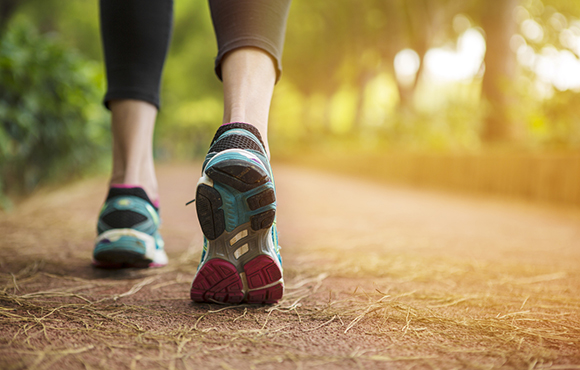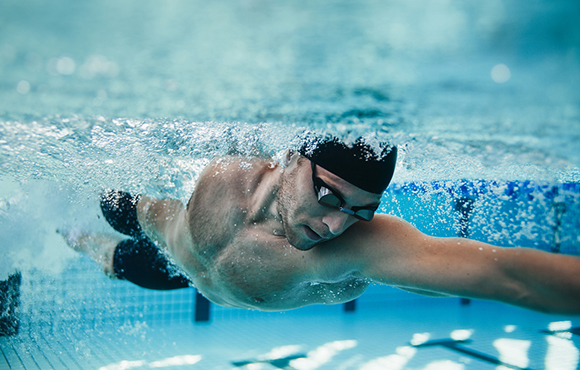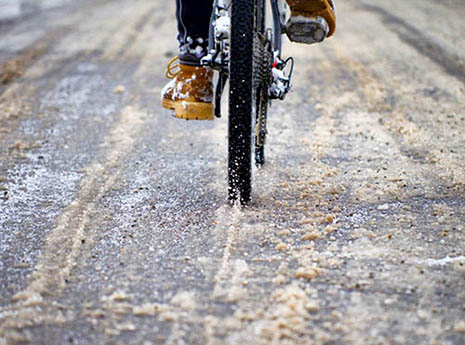While you wait for the roads to clear and the temperatures to rise, try one of these eight cross-training activities that will build your aerobic endurance and keep you fit this winter.
Walking
1 of 18
Walk briskly with your significant other before or after dinner. Notice things around your neighborhood that you don't see when pedaling by. Pressed for time? Three 10-minute brisk walks a day provide almost as much benefit as a 30-minute walk. Walking the dog, while relaxing and fun, generally isn't good aerobic exercise because it's so intermittent.
Find:
Your Next RideHiking
2 of 18
Put extra clothes, lunch and water in a pack and take the family for a hike. Hike briskly enough to elevate your heart rate, but make sure you're still able to talk without becoming out of breath. To get an even better workout for your heart, muscles and bones, toss in some canned goods to make the pack heavier. Remember to dress in layers, just as you would when cycling, so that you can adjust your clothing as you sweat, which can cause your core temperature to dip.
Find:
Your Next RideJogging
3 of 18
First, invest in good shoes. If you aren't used to running, progress slowly. Walk at a brisk pace for 3 to 4 minutes and then jog for a minute or two. Repeat this pattern several times and always finish with an interval of walking. Once you can do this for 30 minutes, increase the jogging intervals by a few minutes and reduce the duration of the walking intervals. Build slowly until you can jog continuously for 30 minutes.
Find:
Your Next RideRunning
4 of 18
If logging miles on the pavement causes joint pain, try trail running, which isn't as hard on the joints. Bring a friend and make sure you maintain a conversational pace.
Find:
Your Next RideSnowshoeing
5 of 18
Snowshoeing is more difficult than hiking because you're forced to lift the snowshoes with every step. Because of the wide stance, it also stresses your muscles differently. Start with short workouts to avoid soreness and injury. Like other activities during the winter, dress in layers so that you can adjust your clothing.
Find:
Your Next RideCross-Country Skiing
6 of 18
Cross-country skiing engages a lot of the same muscles that you use in cycling. Because of this, a lot of bike racers use cross-country skiing as their cross-training method of choice during the winter.
In general, skiing with the classic kick and glide is better for building your endurance because you can ski without going into anaerobic heart-rate zones. Classic skiing is also easier to learn because it involves less technique initially. However, if you're a proficient skate skier, you can skate ski on flat to gently rolling terrain, as long as you can maintain aerobic heart-rate levels.
Find:
Your Next RideRowing
7 of 18
Most gyms have rowing machines as one of the cardio-equipment options. Rowing is an excellent cross-training exercise because most of your power is generated from the legs, just as it is in cycling. You'll also use your back, shoulder and arm muscles, which can be just as helpful for building power on the bike.
Find:
Your Next RideSwimming
8 of 18
Swimming provides an excellent aerobic workout. However, without good technique, you will increase your risk of injury. Until your technique improves, invest in swim lessons to learn the basics. Because swimming doesn't use core cycling muscles, complement it with other aerobic activities a few times per week.
Remember that you're cross training for aerobic endurance. To get the most benefit, your workouts should be at a lower intensity but for longer durations. Short, hard efforts will challenge the anaerobic system instead of building aerobic endurance.
Find:
Your Next RideWalking
10 of 18
Walk briskly with your significant other before or after dinner. Notice things around your neighborhood that you don't see when pedaling by. Pressed for time? Three 10-minute brisk walks a day provide almost as much benefit as a 30-minute walk. Walking the dog, while relaxing and fun, generally isn't good aerobic exercise because it's so intermittent.
Find:
Your Next RideHiking
11 of 18
Put extra clothes, lunch and water in a pack and take the family for a hike. Hike briskly enough to elevate your heart rate, but make sure you're still able to talk without becoming out of breath. To get an even better workout for your heart, muscles and bones, toss in some canned goods to make the pack heavier. Remember to dress in layers, just as you would when cycling, so that you can adjust your clothing as you sweat, which can cause your core temperature to dip.
Find:
Your Next RideJogging
12 of 18
First, invest in good shoes. If you aren't used to running, progress slowly. Walk at a brisk pace for 3 to 4 minutes and then jog for a minute or two. Repeat this pattern several times and always finish with an interval of walking. Once you can do this for 30 minutes, increase the jogging intervals by a few minutes and reduce the duration of the walking intervals. Build slowly until you can jog continuously for 30 minutes.
Find:
Your Next RideRunning
13 of 18
If logging miles on the pavement causes joint pain, try trail running, which isn't as hard on the joints. Bring a friend and make sure you maintain a conversational pace.
Find:
Your Next RideSnowshoeing
14 of 18
Snowshoeing is more difficult than hiking because you're forced to lift the snowshoes with every step. Because of the wide stance, it also stresses your muscles differently. Start with short workouts to avoid soreness and injury. Like other activities during the winter, dress in layers so that you can adjust your clothing.
Find:
Your Next RideCross-Country Skiing
15 of 18
Cross-country skiing engages a lot of the same muscles that you use in cycling. Because of this, a lot of bike racers use cross-country skiing as their cross-training method of choice during the winter.
In general, skiing with the classic kick and glide is better for building your endurance because you can ski without going into anaerobic heart-rate zones. Classic skiing is also easier to learn because it involves less technique initially. However, if you're a proficient skate skier, you can skate ski on flat to gently rolling terrain, as long as you can maintain aerobic heart-rate levels.
Find:
Your Next RideRowing
16 of 18
Most gyms have rowing machines as one of the cardio-equipment options. Rowing is an excellent cross-training exercise because most of your power is generated from the legs, just as it is in cycling. You'll also use your back, shoulder and arm muscles, which can be just as helpful for building power on the bike.
Find:
Your Next RideSwimming
17 of 18
Swimming provides an excellent aerobic workout. However, without good technique, you will increase your risk of injury. Until your technique improves, invest in swim lessons to learn the basics. Because swimming doesn't use core cycling muscles, complement it with other aerobic activities a few times per week.
Remember that you're cross training for aerobic endurance. To get the most benefit, your workouts should be at a lower intensity but for longer durations. Short, hard efforts will challenge the anaerobic system instead of building aerobic endurance.







Discuss This Article